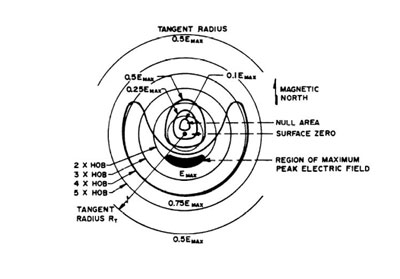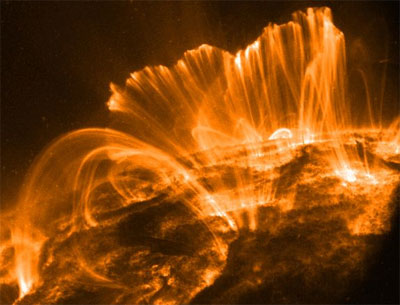The EMP threat: fact, fiction, and response (part 1)by Yousaf M. Butt
|
| I examine the salient technical issues and attempt to compare the threat of nuclear EMP with that from a powerful “once-in-a-century” geomagnetic storm. |
I first briefly describe the source of the various types of electromagnetic pulses that are the sub-components of what is generically termed “EMP”: E1, E2 and E3. To properly assess the effects of EMP on electric power systems, appropriate specifications of these E1, E2, and E3 sub-components are vital. I follow by a short review some historical US and Soviet high-altitude nuclear explosions that took place 1955-1962 in order to see what may be learnt from such archival data. Lastly, I evaluate the possible threat we may face from an EMP attack, as well as that from geomagnetic storms, and conclude with some suggested responses.
Description of nuclear electromagnetic pulses
During the course of a nuclear explosion, gamma rays are produced both by the fission process, and by inelastic scattering of neutrons in the material of the device. Most of these energetic gamma rays are absorbed by the material of the weapon itself and never escape. For typical bomb designs, just 0.1-0.5% of the total bomb yield is expected to be radiated as prompt gamma rays. The higher number corresponds to simple low-yield fission weapons with relatively thin outer casings, and the lower number applies to the more complicated two-stage thermonuclear devices. These prompt gamma-rays are emitted in a relatively thin (on the order of a few meters) spherical shell whose radius increases at the speed of light.
As a nuclear EMP device is exploded at an altitude of between 40–400 kilometers, the downward directed gamma rays collide with electrons in air molecules of the thin upper atmosphere transferring their energy to the electrons via the Compton process. These electrons are ejected from their parent molecules at high energies and, once liberated, collide with other electrons creating a cascade of roughly 30,000 electrons for each original gamma ray [4]. The electrons spiral in the magnetic field of the earth emitting coherent synchrotron radiation. Since this radiation, and the initial excitation gamma-rays, both travel at the speed of light, the EMP radiation field “piles-up” in an analogous manner to a “sonic-boom”: the electromagnetic radiation formed at different distances from the explosion arrives virtually simultaneously to an observer on the ground. The source region of the pulse is located, primarily, in an approximately 10-kilometer-thick region of the atmosphere roughly between 25 and 35 kilometers altitude: well above a 35 kilometers, the density is too low for much production of Compton scattered electrons and much below 25 kilometers, most of the prompt gammas are absorbed [4]. The pulse has a risetime of nanoseconds and usually decays within a microsecond or so. During that short time it can induce fields of, typically, 100 to 30,000 V/m at ground level. However, any ionization present in the source region will tend to “short-out” the EMP. High-energy X-rays are also produced during the explosion and these will enhance the ionization in the high-altitude EMP source region. This source of ionization was largely ignored in EMP assessments until 1986. The inclusion of the X-ray ionization in more recent modeling has lowered the assessed values of the peak EMP fields.
The exact value of the induced peak electric field depends upon the bomb yield, its design, and other factors already mentioned above, such as the detonation altitude, local magnetic field strength, and the geographic latitude of the explosion. Higher geomagnetic field strengths and higher latitudes (i.e. farther away from the equator, north or south) will typically create a stronger peak EMP field, other things being equal.
| An EMP affects electrical systems by “coupling” to them: in effect, electrical devices, and their attachments (e.g. power cables), simply act like antennas which pick-up the EMP signal. |
For a large device (greater than 100 kilotons), significant EMP fields will be induced out to the tangent radius: i.e., the whole region on the Earth’s surface which is within line-of-sight to the high-altitude explosion will experience the EMP pulse. For instance, a detonation at 100 kilometers will expose a circular region of radius 1,120 kilometers on the earth’s surface to the pulse, and a 40-kilometer detonation will expose a region of radius 710 kilometers. The electric field expected towards the periphery of these exposed regions will be roughly half the peak field for high-yield weapons, but—importantly—it will be significantly less in that region for a smaller (~1 kiloton) device [5]. For a burst at high northern latitudes, such as for Europe or America, the peak field region occurs in a broad arc located south of the burst “ground-zero”, due to the orientation of the magnetic field [Fig 1]. Also, since the radiation is produced by electrons’ motion transverse to the Earth’s magnetic field, those electrons moving right along the magnetic field lines will not radiate. There is, therefore, also a region of near-zero field strength just north of “ground-zero”, where the downward-angling magnetic field lines from the elevated burst site intersect the Earth, as shown in the figure below.
The exact pulse profile (rise and decay time) also depends on the location of the observer in the exposed region: in general, further away from the peak-field region the pulse will have a slower rise and decay. [6]
The above discussion applies to the prompt, high-amplitude, “E1”, signal from the nuclear detonation. However, this pulse is immediately followed by lower-amplitude, but longer-lasting, “E2” and “E3” EMP signals.
The E2 part of the EMP arises from previously scattered ambient gammas, as well as from the inelastic scattering of the weapon-produced neutrons from the nuclei of air molecules—a process which also yields copious gamma-rays external to the device. The eventual capture of the progressively slowing neutrons results in additional gamma-rays, as does the prompt decay of some of the fission products. The sum of these variously-produced gammas leads to an impulsive Compton electron current (due to the separation of the electrons from their parent molecules) that depends on the polar angle because of the atmospheric density gradient. There is also a non-compensated vertical current directly below the detonation. The resultant “E2” pulse has a duration of up to about 1 second. [7]
 Fig 1: Variation of the E1 EMP field strength on the region of earth within line-of-sight of the elevated burst, for a large nuclear device (>100 kT) exploded in the northern hemisphere. The peak electric field region is shown by the dark shaded arc just south of “ground-zero”. For a smaller device, the E1 electric field at the tangent radius will be significantly less than 0.5 of the peak value (Glasstone and Dolan, 1977). “HOB” refers to the height of the burst. For a 40km burst (an optimal altitude for a small weapon – see Section V), the tangent radius is 710km, but substantial E1 fields would not be expected outside about 10xHOB, or a 400km radius, for a 1kt device. (credit: FAS) |
The even lower-amplitude—but longer-lasting—E3 EMP pulse comes about as a result of the ionized explosive fireball expanding and “expelling” the earth’s magnetic field (due to the fact that it is an electrically-conductive region), in a “heaving” action. For this reason, it is also known as the Magneto-hydrodynamic (MHD) pulse. This pulse can last up to 1,000 seconds or longer and has with a frequency of less than 1 Hertz.
Directly under the burst point, a temporary layer of ionized air is created by the atmospheric absorption of X-rays produced by the weapon. This region tends to shield the area under the burst for the “early” portion of the MHD-EMP signal. As time progresses, however, the hot ionized air under the burst begins to rise and move across the earth’s geomagnetic field lines causing large atmospheric currents to flow. These ionospheric currents likely account for the second phase (>10 sec) of the MHD-EMP signal. [8]
Lastly, the auroral motion of charged particles from the detonation, spiraling along the earth’s magnetic field between conjugate points in opposite hemispheres, results in a final EMP at extremely low frequencies, typically 0.01 Hertz. The E3 (and Auroral) EMP is the most similar to that associated with natural geomagnetic storms, and is the one that most directly threatens long-line power delivery systems [9]. The E3 pulse is low frequency pulse which, unlike the high frequency E1 and E2 pulses, can penetrate the ground, where it can induce substantial electric currents in very long (over 100 kilometers long) buried cables. [10].
Coupling of the three EMP components to ground systems
An EMP affects electrical systems by “coupling” to them: in effect, electrical devices, and their attachments (e.g. power cables), simply act like antennas which pick-up the EMP signal. The different types of EMP—E1, E2, and E3—couple in different ways to the various types of electrical systems.[11,12]
The prompt E1 couples well to local antennas, short (1–10 m) cable runs, equipment in buildings (through apertures), and can disrupt or damage integrated circuit (IC)-based control systems, sensors, communication systems, protective systems, computers, and similar devices. The most common protection against the effects of E1 is the use of electromagnetic shielding, filters, and surge arresters [11].
E2 couples well to longer conductive lines, vertical antenna towers, and aircraft with trailing wire antennas. It is similar to lightning in its time-dependence, but would, of course, be more geographically widespread, while being lower in intensity, especially for a low-yield weapon. As the EMP commission acknowledges, the E2 pulse would not, in general, be an issue for critical infrastructure systems since they already have protective measures for defense against occasional lightning strikes.
| It is useful to review the actual measured effects of EMP from Cold War ear nuclear tests. |
The E3 pulse couples well to power and long communications lines including undersea and underground cables. The low frequencies (sub-Hertz) of E3 make shielding and isolation difficult. Experience from both geomagnetic storms and 1960s-era Russian and American nuclear testing indicates that there is a great likelihood of commercial power and landline disruption from E3 pulses of powerful (>100 kt) nuclear devices. Small isolated systems will however, typically, be unaffected by E3. The E3 environment is so slowly varying that quasi-DC analysis models are appropriate for estimating the behavior of the induced power system responses.
Dr. Radsaky and Mr. Kappenman have summarized the effects of E1 and E3 from a large nuclear device in their statement before the House Homeland Security Subcommittee on Emerging Threats, Cybersecurity, and Science and Technology:
For the operation of the electric power grid, the… E1 and E3 pulses are the most important. Research performed for the EMP Commission clearly indicates the following concerns:
1) Malfunctions and damage to solid-state relays in electric substations (E1)
2) Malfunctions and damage to computer controls in power generation facilities, substations, and control centers (E1)
3) Malfunctions and damage to power system communications (E1)
4) Flashover and damage to distribution class insulators (E1)
5) Voltage collapse of the power grid due to transformer saturation (E3)
6) Damage to [High Voltage] HV and [Extremely High Voltage] EHV transformers due to internal heating (E3)
The E1, E2, and E3 EMP subcomponents scale differently with weapon yield (and design) so it is important to be clear what effects one is interested in: i.e. effects on IC-based electronics (which couple strongly with E1) or electrical power systems connected to long-lines (which couple most strongly with E3, and auroral EMP). The salient issues are, then, what strengths of E1 and E3 pulses one may expect over what parts of the country from the types of devices adversarial states possibly possess (or may possess in the foreseeable future) and, of course, how likely the actors are to carry out such an attack. Before addressing those questions, it is useful to review the actual measured effects of EMP from Cold War ear nuclear tests.
